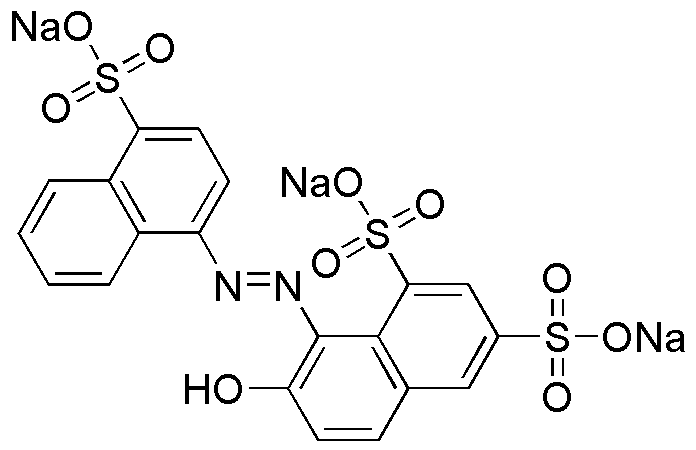New Coccine is widely utilized in research focused on:
- Dye Industry: It serves as a vibrant dye for textiles, providing bright colors that are resistant to fading, making it ideal for fashion and home décor applications.
- Biological Staining: In laboratories, it is used for staining biological specimens, enhancing visibility under a microscope, which is crucial for biological research and diagnostics.
- Food Coloring: New Coccine is employed as a food additive, offering a safe and appealing color to various food products, thus enhancing their marketability.
- Cosmetics: The compound is also found in cosmetic formulations, where it provides color to products like lipsticks and eyeshadows, ensuring they meet consumer preferences for vibrant shades.
- Environmental Monitoring: Its application in environmental science includes tracking pollutants in water bodies, helping researchers assess the impact of industrial activities on ecosystems.
Informations générales
Propriétés
Sécurité et réglementation
Applications
New Coccine is widely utilized in research focused on:
- Dye Industry: It serves as a vibrant dye for textiles, providing bright colors that are resistant to fading, making it ideal for fashion and home décor applications.
- Biological Staining: In laboratories, it is used for staining biological specimens, enhancing visibility under a microscope, which is crucial for biological research and diagnostics.
- Food Coloring: New Coccine is employed as a food additive, offering a safe and appealing color to various food products, thus enhancing their marketability.
- Cosmetics: The compound is also found in cosmetic formulations, where it provides color to products like lipsticks and eyeshadows, ensuring they meet consumer preferences for vibrant shades.
- Environmental Monitoring: Its application in environmental science includes tracking pollutants in water bodies, helping researchers assess the impact of industrial activities on ecosystems.
Documents
Fiches de données de sécurité (FDS)
La FDS fournit des informations de sécurité complètes sur la manipulation, le stockage et l’élimination du produit.
Spécifications du produit (PS)
Le PS fournit une description complète des propriétés du produit, notamment sa composition chimique, son état physique, sa pureté et les exigences de stockage. Il détaille également les plages de qualité acceptables et les applications prévues du produit.
Certificats d'analyse (COA)
Recherchez des certificats d'analyse (COA) en saisissant le numéro de lot du produit. Les numéros de lot et de lot se trouvent sur l'étiquette d'un produit, après les mots « Lot » ou « Lot de fabrication ».
Numéro de catalogue
Numéro de lot/série
Certificats d'origine (COO)
Ce certificat d'exploitation confirme le pays dans lequel le produit a été fabriqué, et détaille également les matériaux et composants utilisés et s'il est issu de sources naturelles, synthétiques ou autres sources spécifiques. Ce certificat peut être requis pour les douanes, le commerce et la conformité réglementaire.
Numéro de catalogue
Numéro de lot/série
Fiches de données de sécurité (FDS)
La FDS fournit des informations de sécurité complètes sur la manipulation, le stockage et l’élimination du produit.
DownloadSpécifications du produit (PS)
Le PS fournit une description complète des propriétés du produit, notamment sa composition chimique, son état physique, sa pureté et les exigences de stockage. Il détaille également les plages de qualité acceptables et les applications prévues du produit.
DownloadCertificats d'analyse (COA)
Recherchez des certificats d'analyse (COA) en saisissant le numéro de lot du produit. Les numéros de lot et de lot se trouvent sur l'étiquette d'un produit, après les mots « Lot » ou « Lot de fabrication ».
Numéro de catalogue
Numéro de lot/série
Certificats d'origine (COO)
Ce certificat d'exploitation confirme le pays dans lequel le produit a été fabriqué, et détaille également les matériaux et composants utilisés et s'il est issu de sources naturelles, synthétiques ou autres sources spécifiques. Ce certificat peut être requis pour les douanes, le commerce et la conformité réglementaire.


